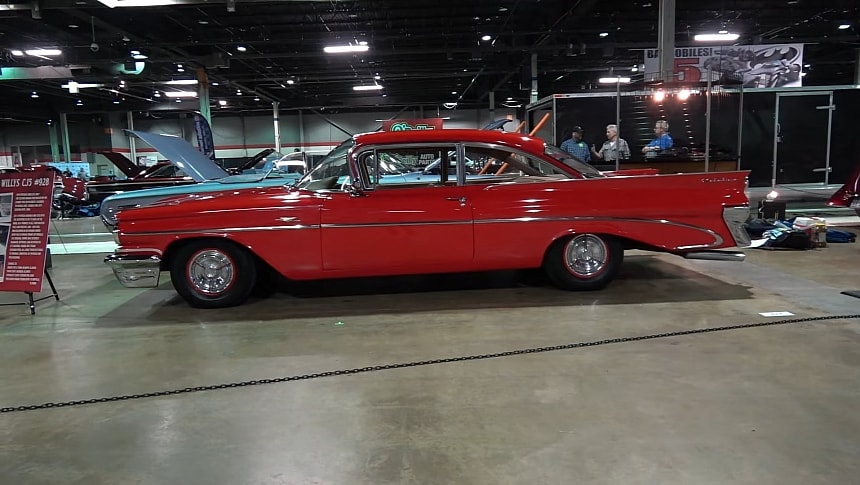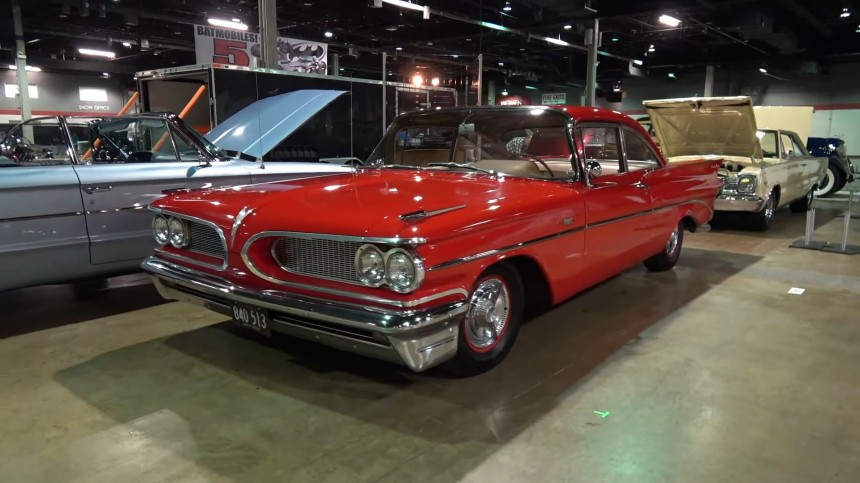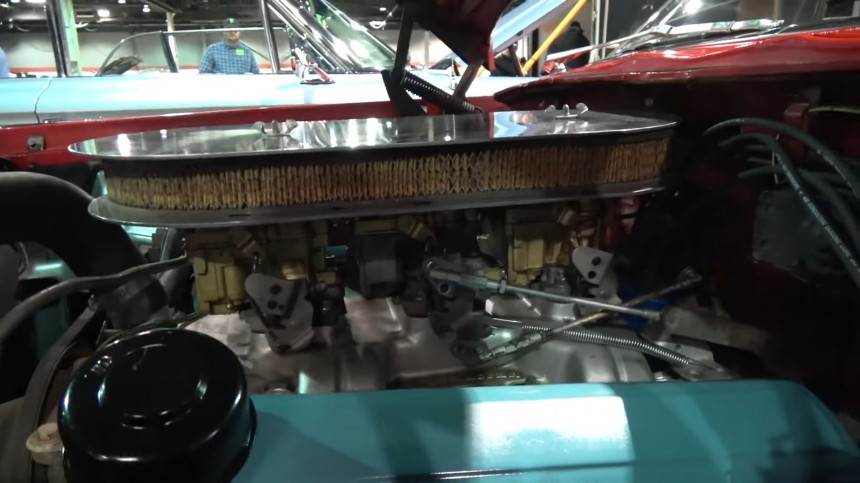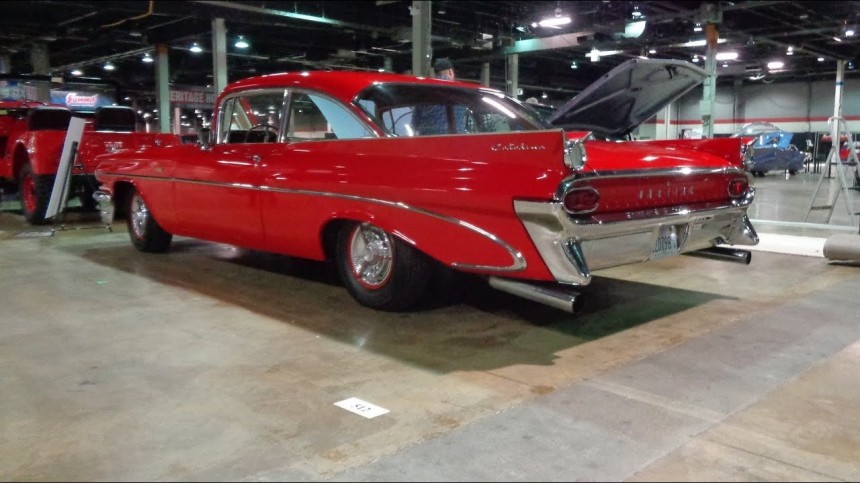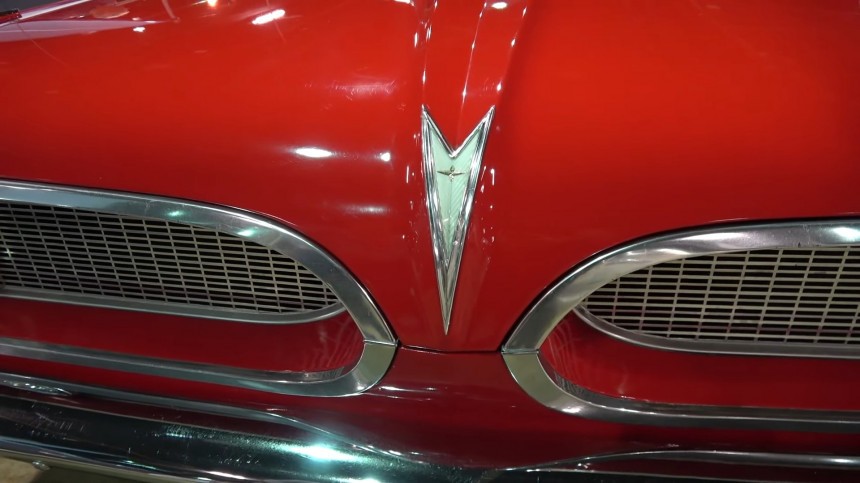Introduced in 1950 as a trim line reserved for hardtops only on the 1950 Chieftain Eight and DeLuxe Eight lines, the Catalina became a separate model as the entry-level full-size Pontiac in 1959. It was a short first generation that lasted two model years, each with its distinct styling. The debut model had a better-looking stance, with the signature split grille, quadruple tailfins, jet-age lines, and new wide tracks.
Giving the entire lineup a fresh new look was a smart decision from Pontiac’s execs. The General Motors division propelled itself into fourth overall in sales, behind the far-ahead Chevrolet and Ford and trailing Plymouth by a sizeable margin. With 382,940 automobiles produced, Pontiac inched just ahead of the corporate siblings from Oldsmobile, which only managed to reach 382,864 units.
The nameplate was carried by seven body styles (two- and four-door post sedans, two- and four-door pillarless sedans – or hardtops, if you prefer – a convertible, and two station wagons). 231,561 Catalinas were assembled in total – the model was a huge success for Pontiac relative to the division’s scale in the overall car environment of the late fifties.
It probably helped the soaring sales that the Eisenhower recession was easing out, but Pontiac engineers and designers did their best to impress. A year before the introduction of the Catalina line, Pontiac sold 216,982 cars, less than what the best-selling model scored in its debut year. With nine engines and two transmissions, there was a Catalina for everyone.
Technically, there was a single engine, a 389 cubic-inch V8 (6.4-liter) that came in nine different states of tune, ranging from a two-barrel, low-compression version that offered 215 hp and 390 lb-ft (218 PS, 529 Nm) up to the NASCAR-certified Super Duty 420-A Block that put out 345 hp and 420 lb-ft (350 PS, 576 Nm). The latter had a triple two-barrel carburetor fuel system, a 10.5:1 compression ratio, and hot internals.
The trio of two-pot carbs was going under the commercial moniker of ‘Tri-Power,’ and it wasn’t among the popular powertrain choices of buyers back then. An urban legend has it that the triple carburetion was frowned upon by buyers after getting wind of '57 and '58 Oldsmobile convertibles with said three two-barrels (with vacuum linkages) and automatic transmissions.
Olds 98 droptops were typically bought by more composed drivers (middle-aged or seniors). Their cautious driving styles didn't trigger the end carbs to open. As the fuel evaporated, the float bowls were slowly varnished with gasoline residue.
A rough estimate puts the total Tri-Power production for Pontiac at less than a tenth of the total volume – some sources would go for an even lower portion of less than five percent. That makes such equipped automobiles rare nowadays, even more so if they’re original survivors.
Here’s one that ticks both boxes and adds a few cool touches on top. Found – and filmed – by Lou Costabile at the World of Wheels car show last March, the venerable ’59 Catalina two-door Sport Sedan. That’s a coupe in 50s’ parlance, and this bright red example sports the mainstream choice Hydra-Matic transmission.
Of all the Catalinas built for the model year, 9,939 had three-speed Synchromesh manual gearboxes, and 221,622 had four-speed automatic (four forward ranges, plus one reverse). The owner of this 67,811-mile survivor (109,131 kilometers at the time of filming, over two months ago) bought the car online.
He was looking for a specific automobile that had to meet three requirements simultaneously: It had to be a Pontiac from 1959 and a Catalina. He filtered the results and ended up with a very short list consisting of precisely one car – this one.
The 1959 Catalina embodies the debut year for several of Pontiac’s trademark features that would endure for years and boost sales to all-time records for the company. The distinctive split-grille styling would be one of those traits, and it came almost accidentally.
Pontiac designers experimented with a conventional, full-width oval grille with dual headlights at each end. At one point, they cut it in two and moved each piece to its outward limit. With the lamps at the extremities, the center gained the open-ended look that would become one of the brand’s most distinguishable characteristics.
Another one was the five-inch-wider track, which pushed the wheels outward to take up all the room under the fenders. This had an immediate effect on the looks, but more importantly, it drastically improved the car's stability and handling. This particular example in our story has one peculiar detail that sets it apart from the rest of its siblings: the Ford air cleaner cover.
Traditionally, the Tri-Power setup implied separate air filters for each of the three carburetors, but this car was once owned by a man who also built carburetor lids for Ford race cars. If this looks suspiciously close to a FoMoCo high-performance product of the early sixties, now you know why.
The nameplate was carried by seven body styles (two- and four-door post sedans, two- and four-door pillarless sedans – or hardtops, if you prefer – a convertible, and two station wagons). 231,561 Catalinas were assembled in total – the model was a huge success for Pontiac relative to the division’s scale in the overall car environment of the late fifties.
It probably helped the soaring sales that the Eisenhower recession was easing out, but Pontiac engineers and designers did their best to impress. A year before the introduction of the Catalina line, Pontiac sold 216,982 cars, less than what the best-selling model scored in its debut year. With nine engines and two transmissions, there was a Catalina for everyone.
The trio of two-pot carbs was going under the commercial moniker of ‘Tri-Power,’ and it wasn’t among the popular powertrain choices of buyers back then. An urban legend has it that the triple carburetion was frowned upon by buyers after getting wind of '57 and '58 Oldsmobile convertibles with said three two-barrels (with vacuum linkages) and automatic transmissions.
Olds 98 droptops were typically bought by more composed drivers (middle-aged or seniors). Their cautious driving styles didn't trigger the end carbs to open. As the fuel evaporated, the float bowls were slowly varnished with gasoline residue.
Here’s one that ticks both boxes and adds a few cool touches on top. Found – and filmed – by Lou Costabile at the World of Wheels car show last March, the venerable ’59 Catalina two-door Sport Sedan. That’s a coupe in 50s’ parlance, and this bright red example sports the mainstream choice Hydra-Matic transmission.
Of all the Catalinas built for the model year, 9,939 had three-speed Synchromesh manual gearboxes, and 221,622 had four-speed automatic (four forward ranges, plus one reverse). The owner of this 67,811-mile survivor (109,131 kilometers at the time of filming, over two months ago) bought the car online.
The 1959 Catalina embodies the debut year for several of Pontiac’s trademark features that would endure for years and boost sales to all-time records for the company. The distinctive split-grille styling would be one of those traits, and it came almost accidentally.
Pontiac designers experimented with a conventional, full-width oval grille with dual headlights at each end. At one point, they cut it in two and moved each piece to its outward limit. With the lamps at the extremities, the center gained the open-ended look that would become one of the brand’s most distinguishable characteristics.
Traditionally, the Tri-Power setup implied separate air filters for each of the three carburetors, but this car was once owned by a man who also built carburetor lids for Ford race cars. If this looks suspiciously close to a FoMoCo high-performance product of the early sixties, now you know why.
